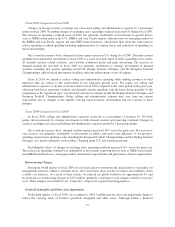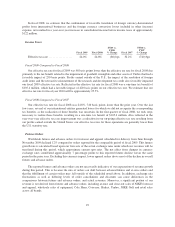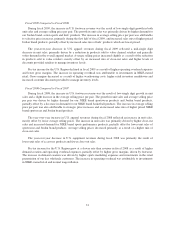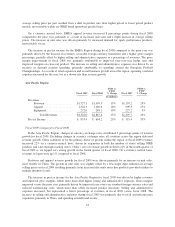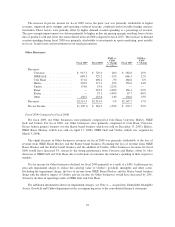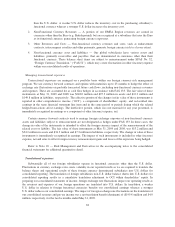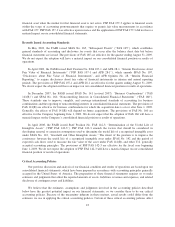Nike 2009 Annual Report Download - page 38
Download and view the complete annual report
Please find page 38 of the 2009 Nike annual report below. You can navigate through the pages in the report by either clicking on the pages listed below, or by using the keyword search tool below to find specific information within the annual report.
Fiscal 2008 Compared to Fiscal 2007
The increase in Other business revenues was driven by higher revenues across most businesses, most
notably Converse and NIKE Golf. The increase in Converse and NIKE Golf is mainly driven by strong consumer
demand both in the United States and international markets. The growth at Cole Haan is mainly driven by the
strong results at Company-owned retail stores.
During fiscal 2008, growth at Converse and NIKE Golf, combined with margin improvements across most
businesses drove the year-over-year increase in pre-tax income. Fiscal 2007 pre-tax income included a $14.2
million benefit relating to the settlement of an arbitration ruling involving Converse and a former South
American licensee. Fiscal 2008 pre-tax income for our Other businesses would have increased approximately
18% versus fiscal 2007 excluding this favorable settlement.
On March 3, 2008, we completed the acquisition of 100% of the outstanding shares of Umbro, a United
Kingdom-based global soccer brand, for a purchase price of £290.5 million in cash (approximately $576.4
million), inclusive of direct transaction costs. This acquisition was intended to strengthen our market position in
the United Kingdom and expand NIKE’s global leadership in soccer, a key area of growth for the Company. This
acquisition also provides positions in emerging soccer markets such as China, Russia and Brazil. The results of
Umbro’s operations have been included in the Company’s consolidated financial statements and in the “Other”
operating segment since the date of acquisition. Umbro, which was listed on the London Stock Exchange prior to
our acquisition, reported in their 2006 annual report that revenues for calendar year 2006 were approximately
$276 million (£149.5 million), and estimated that the combination of Umbro’s calendar year 2006 wholesale
revenue and estimated sales revenue earned by Umbro’s licensees from the sale of Umbro products totaled
approximately $755 million (£409.4 million).
Following a strategic review of the Company’s existing business portfolio, we concluded that the Starter and
NIKE Bauer Hockey businesses did not align with our long-term growth priorities. On December 17, 2007 we
completed the sale of the Starter brand business for $60 million in cash. On April 17, 2008, we completed the
sale of the NIKE Bauer Hockey business for net proceeds of $189.2 million after working capital adjustments.
These transactions resulted in gains of approximately $28.6 million and $32.0 million, respectively, which are
reflected in the Corporate line in our segment presentation of pre-tax income in the accompanying notes to the
consolidated financial statements (Note 19 — Operating Segments and Related Information).
Corporate Expense
Fiscal 2009 Fiscal 2008
FY09 vs.
FY08
% Change Fiscal 2007
FY08 vs.
FY07
% Change
(In millions)
Corporate Expense ............... $(1,629.1) $(1,482.4) -10% $(1,250.7) -19%
Fiscal 2009 Compared to Fiscal 2008
Corporate expense consists of unallocated general and administrative expenses, which includes expenses
associated with centrally managed departments, depreciation and amortization related to the Company’s
corporate headquarters, unallocated insurance and benefit programs, foreign currency gains and losses, including
hedge gains and losses, corporate eliminations and other items.
The increase in corporate expense in fiscal 2009 was primarily attributable to pre-tax restructuring charges
of $195 million, consisting primarily of cash charges related to severance costs.
36



